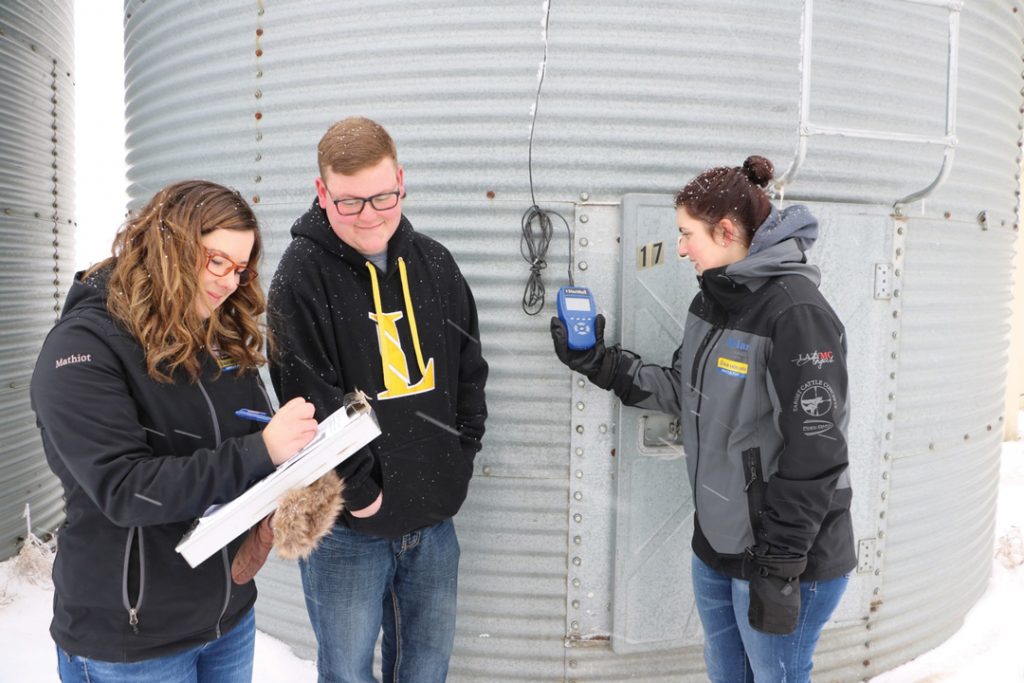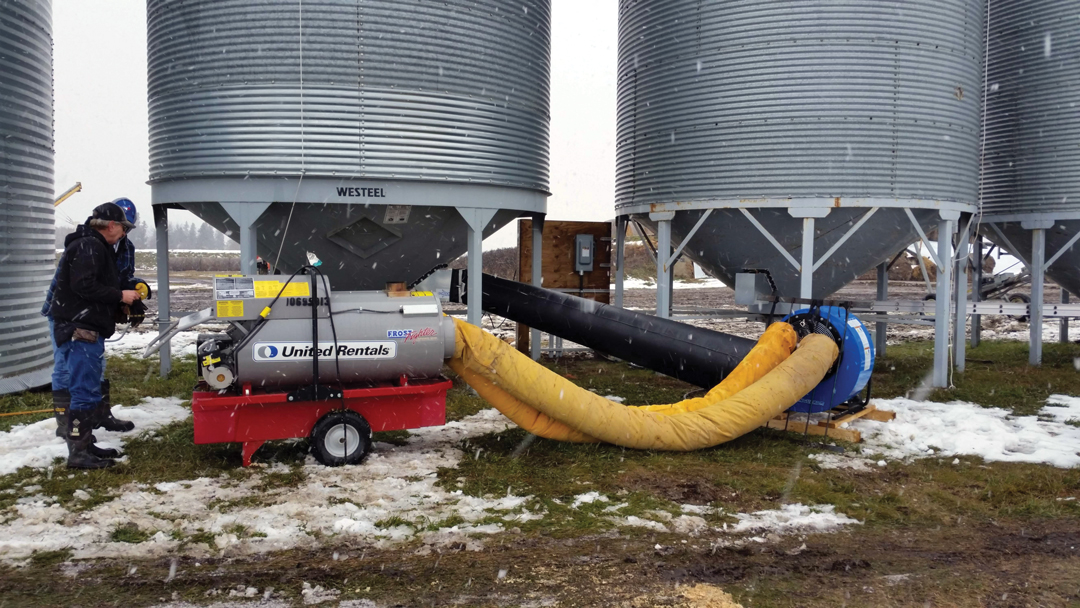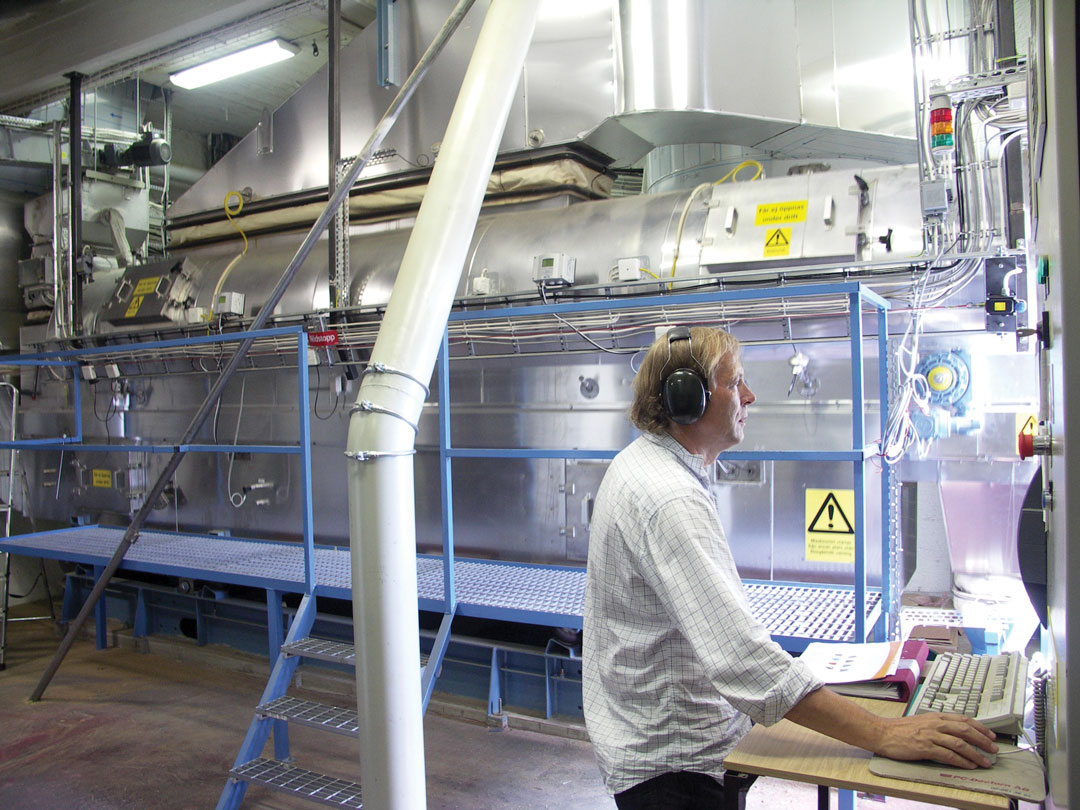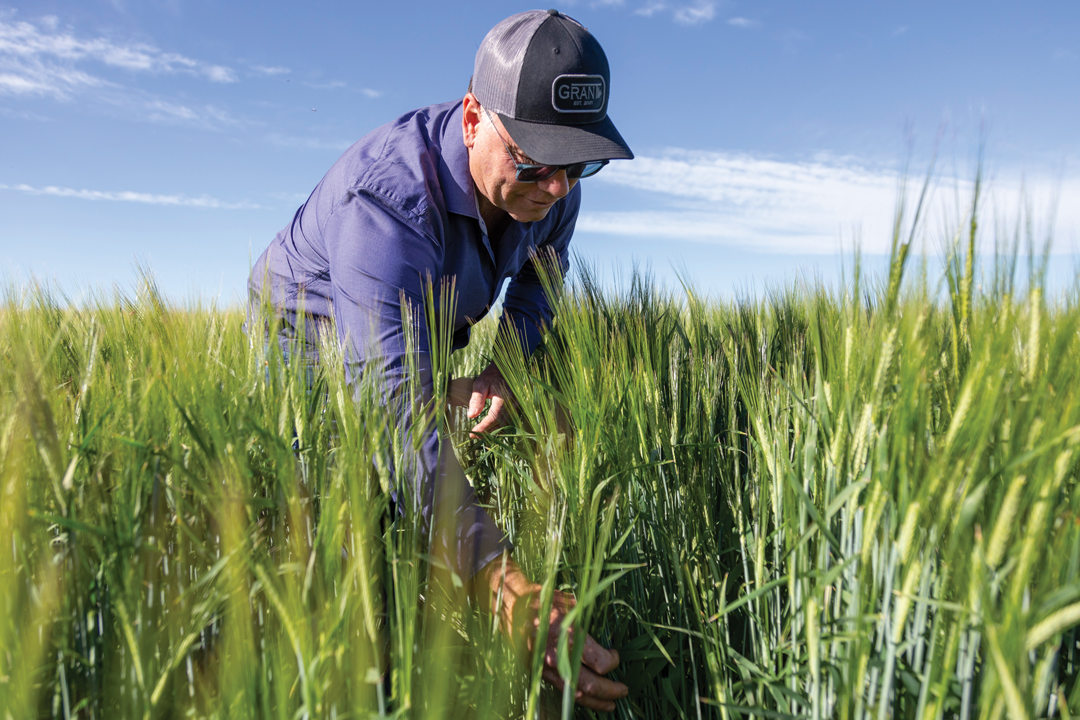IN-BIN OPTIONS
BY CULLEN BIRD • PHOTOS COURTESY OF KYLE KIPPS AND LAKELAND COLLEGE
Low-tech air drying of grain may be a farming practice tailor made for these wet, financially constrained times. Multiple tough harvests have increased grain drying demands on Alberta farmers at a time when average farm income is down substantially. Can natural in-bin airdrying or natural aeration help Prairie farmers cope, and at an attractive price? Employing differing airflow levels, both involve blowing air into grain bins to dry harvested grain.
Alberta farmers haven’t had to worry about on-farm drying until relatively recently, said Joy Agnew, Olds College director of applied research. “When these terrible harvests came along, a lot of them never had to dry before,” she said. “Didn’t have the infrastructure, didn’t have the knowledge.”

From left to right, Lakeland College students Amanda Mathiot, Austin Bartko and Nora Lazarko monitor the temperature of grain stored on the Student-Managed Farm. Students profitably used natural air drying to condition their wet crop.
THE COLLEGE TRY
A recent project conducted by students at Lakeland College in Vermilion suggests there is real potential in low-tech air drying. Last fall, about 80 per cent of the wheat and canola on the Lakeland Student-Managed Farm’s 600-acre crop technology farm came off tough, said JP Pettyjohn, a faculty instructor in Lakeland’s crop technology program. “The weather was just not co-operating,” he said.
Students chose to use natural air-drying with supplemental heat to condition their own wet crop. The college didn’t have dryers, so the students rigged up an in-bin air-drying system with supplemental heat from two diesel Frost Fighter heaters, one a rental, the other owned by the college. They ran their dryers and the Frost Fighter heaters 24 hours a day, refuelling three times a day.
“It is very labour intensive,” said Carter Bodell, a second-year Lakeland student in charge of the analysis team for the 52-student class. The students were able to dry their wheat down from 18 per cent moisture content to 12 per cent, at a cost of 54 cents per bushel. The process proved cheaper than taking the grain to a commercial dryer, said Pettyjohn.
DRYING DATA
Not every farmer is willing or able to purchase an on-farm drying system. “I’m hearing of a lot of farmers taking the penalty and taking tough grain to the elevator and taking that penalty because they don’t have the infrastructure or they don’t have the desire to have to deal with it,” said Agnew.
Which method a farmer uses likely depends on the time, money and energy they have to spend. Of all the possible grain-drying options, the cheapest is natural aeration. Its low cost is the central reason a farmer may use natural aeration rather than trucking wet grain to a commercial dryer, said Ron Palmer. Palmer is a retired University of Regina engineering professor and former project engineer at Indian Head Agricultural Research Foundation.
“If you use natural aeration you can get the cost right down and get your grain in great shape without having to resort to expensive fuel and the inconvenience of commercial drying,” he said.
In 2018, Palmer completed a study for the Western Grains Research Foundation on natural air-drying, drawing on more than 10 years of research. It found pushing cool air over warm grain results in drying, and the best time for natural aeration is at night. “I know it sounds wrong, that you’d be cooling your grain down to dry it, but that’s what all our data shows—cooling is drying,” said Palmer.
As the fan pushes cool air through the warmer grain, it takes on heat energy from the kernels and warms up. As the air warms, it carries moisture out of the grain. The first 24 hours after the grain is stored are critical, he emphasized. “In fact, while you’re filling the bin, that aeration fan should be on,” he said. “It doesn’t have to be a huge fan, but it should be done immediately. For every 15 degrees that you decrease the temperature of the grain, you take about a point of moisture out.”
The results of Palmer’s decade-long study suggest drying typically starts at 6 p.m. and ends at 9:30 a.m., with the best drying occurring at 2 a.m. After the initial 24 hours, the best time to turn the fan on again is at night when the cool night offers the best drying potential. However, Palmer emphasized natural aeration’s most important benefit is not drying, but conditioning and cooling the grain so it won’t spoil.
TURNING UP THE HEAT
Agnew agreed there is great drying potential in natural aeration, but only to a degree. It has limitations, she said. “In-bin, natural air-drying is great in August and September and some part of October, but it’s no longer useful past that time,” she said.
If the initial difference between the ambient air temperature and the warm grain is large enough, there is great drying potential. The problem is that the drying efficiency of air decreases as the temperature goes down, said Agnew. As well, the process generally only takes one or two percentage points of moisture out, she added.
In colder harvest weather, in-bin drying requires heaters, she said. “The challenge or the key is getting enough airflow rate,” she said. To use natural air-drying, farmers need fans with capacity high enough to maintain adequate airflow in their grain bins.
A number of configurations work well, she said, but farmers should also set up their systems to support frequent turning of the grain being heated and dried. This is because the grain will dry unevenly, from the bottom up, and hotspots can quickly form and grow.
“That means pulling the grain out of one bin, ideally, and putting it in another,” she said. If another bin isn’t available, remove the bottom third of the grain and place it back on top.
Agnew also hopes that guidelines for proper venting of grain bins are developed and published for public use. “A lot of these bins aren’t designed for rapid expelling of moist air,” said Agnew.
A DOWNWARD TREND
Harvest data published in Alberta crop reports indicate late harvests are becoming more common, said Agnew. Defined as any harvest occurring after early October, late harvests have been increasingly frequent over the last number of years. “Harvest has been significantly delayed the last six years running in Alberta,” she said.
Since grain drying via natural aeration slows down greatly at low temperatures, the late-harvest trend is exacerbating this drawback. And for the farmer who wants to dry grain quickly for immediate sale, natural aeration isn’t the answer. “You’re out of luck,” said Palmer. “Natural aeration isn’t going to cut it for you.” Natural aeration requires patience and the inconvenience of monitoring the process. “The most important thing is you can keep it safe without spoiling,” he added.
Natural aeration isn’t very effective in wet, cold weather, said Palmer. “I got call after call in this wet weather,” he said. “‘We took our grain off and it’s wet, and it’s cold. What do we do about it now?’” In this situation, he explained, the grain doesn’t have any heat energy to fuel the natural aeration process.
Reflecting this, the Lakeland College students had tried to use natural aeration on their first crop of barley in late September, turning on the fan during the heat of the day and turning it off at night. However, by the last week of September, temperatures were too low to get much drying done. This is when the students switched to air-drying with supplemental heat.
Farmers usually resort to supplemental heat, and here there’s also a potential pitfall. “The problem is that that nice warm air gets to the top of the grain, hits the cold roof, and guess what happens? It condenses—it rains back down onto the grain,” said Palmer. To avoid this, Palmer recommends adding a little supplemental heat during the day, and cycling it out at night by running the aeration fan without heat.
PLANNING FOR THE FUTURE
If Lakeland College students harvest another late, wet crop they will likely use natural air-drying again, said Pettyjohn. The technique was successful, and the drying process didn’t diminish the quality of the grain. The students were able to sell their wheat at No. 2. “I think it’s the only logical option we have at the college,” he said.
But Bodell isn’t sure the same process would work well where manpower is in short supply or when there’s a high volume of grain to be dried. “It’s nice being able to walk away from it and letting it dry, but having to refuel every eight hours can be a challenge if you’re busy,” he said.
Whether it’s a shift in climate patterns or a run of really bad luck, the increasing frequency of late harvests caused by poor weather demands action said Agnew. “I hope the trend of poor weather during harvest doesn’t continue, but it will be wise for us to define and adopt practices to mitigate the risks in case it does continue.”







Comments